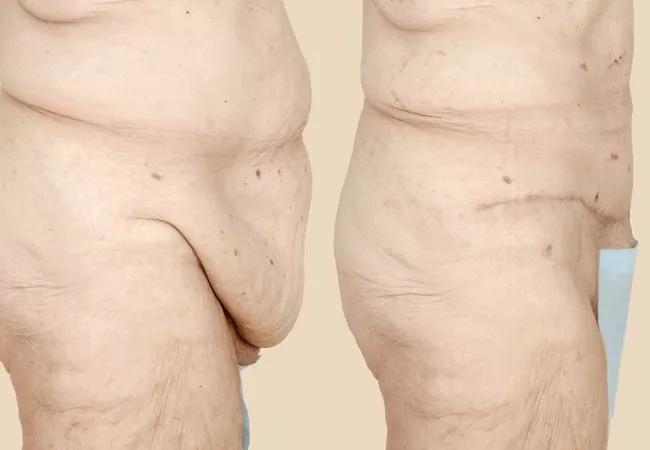Individually tailored procedures increase patient satisfaction

In recent years, abdominoplasty techniques have changed dramatically and one size no longer fits all. Where once traditional dermolipectomy and wide undermining were the norm, the modern approach is much more conservative.
Advertisement
Cleveland Clinic is a non-profit academic medical center. Advertising on our site helps support our mission. We do not endorse non-Cleveland Clinic products or services. Policy
According to James E Zins, MD, Chairman of the Department of Plastic Surgery in Cleveland Clinic’s Dermatology & Plastic Surgery Institute, today surgeons can tailor the operation to the patient and address special situations — and they need to understand how to do so.
“We can vary abdominoplasty depending on the patient’s problem,” says Dr. Zins. “For individuals with relatively mild or moderate skin excess, we can make a limited incision and avoid a scar around the umbilicus, which means a faster recovery. A more traditional operation, in contrast, requires a larger incision and more surgical undermining.”
While the volume of information for plastic surgeons to absorb on the new approaches may seem daunting, they need only turn to a new monograph co-edited by Dr. Zins and Alan Matarasso, MD, Immediate Past President of the American Society of Plastic Surgeons. Part of the Plastic Surgery Clinics series, Abdominoplasty: State of the Art provides step-by-step information on individual procedures and guidance for patient care that will enable practitioners to incorporate the latest techniques into their treatment armamentarium.
Of the publication, says Dr. Zins, “In 10 chapters, this monograph delves into the details of specific procedures and a wide variety of minimally invasive and more extensive procedures, rather than just offering a single surgeon’s experience or perspective.”
The techniques covered run the gamut and include lipoabdominoplasty with anatomic definition, use of progressive tension sutures (PTS) to eliminate the need for drains, combination procedures to create global aesthetic improvement while minimizing complications, noninvasive abdominoplasty, abdominal etching and high-definition excisional body contouring. Expert perspectives also are provided on prophylaxis for deep venous thrombosis and BODY-Q scales for outcomes measurement.
Advertisement
An issue of increasing clinical importance highlighted in one chapter is abdominoplasty in the setting of massive weight loss (MWL), a procedure with which Dr. Zins has significant experience.
“At Cleveland Clinic, we have treated a large population of patients that have MWL — loss of over 100 lb. With it comes a significant amount of skin excess, which requires body contouring,” he says. “In the past, we were only able to do it successfully in selected cases, but today, we can do total lower body lifts, arm lifts and medial thigh lifts, with varied incisions.”
Another advance highlighted in the monograph is use of liposuction in combination with abdominoplasty to achieve global aesthetic improvement while reducing complications. “Liposuction is a common adjunctive procedure, and at Cleveland Clinic, we’ve found that it we can use it very safely with abdominoplasty to remove fat in the saddle bag and hip areas and in the bra roll and enhance surgical results,” says Dr. Zins.
In the past, placement of drains was common during abdominoplasty, but according to Dr. Zins, they now are a thing of the past. “Plastic surgeons need to know that drains — which patients find uncomfortable — can be eliminated with PTS. The procedure for PTS placement has been simplified and shortened and it’s described in detail in the monograph.”
When it comes to outcomes of abdominoplasty, until recently, judgment about its aesthetic results was largely subjective. But that, too, has changed.
“What one patient thinks is attractive, in terms of body contouring, another may not find acceptable,” says Dr. Zins. “With the BODY-Q, we have a condition-specific patient-reported outcome measure. At Cleveland Clinic, it has become a very, very important part of our postoperative evaluation and allows us to objectively rather than subjectively evaluate the results of our surgical procedures.”
Advertisement
Use of the BODY-Q scales also is described in the abdominoplasty monograph. The scales, which cover a range of content domains and focus on the effects of the procedure on health-related quality of life and appearance, can be tailored to an individual surgeon’s needs.
Says Dr. Zin’s of Abdominoplasty: State-of-the-Art, “It’s really designed to give plastic surgeons a very good overview of the whole complexity of body contouring surgery from authors who are experts. Readers will get an understanding of general innovations in abdominoplasty across the board and specific advances in the last five to seven years in context of previous literature.”
Advertisement
Advertisement

Family history may eclipse sun exposure in some cases

Consider secondary syphilis in the differential of annular lesions

Persistent rectal pain leads to diffuse pustules

Two cases — both tremendously different in their level of complexity — illustrate the core principles of nasal reconstruction

Stress and immunosuppression can trigger reactivation of latent virus

Low-dose, monitored prescription therapy demonstrates success

Antioxidants, barrier-enhancing agents can improve thinning hair